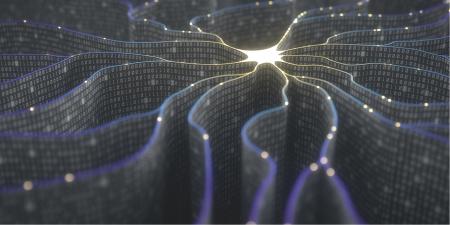Abstract
Available medical knowledge exceeds the organizing capacity of the human mind, yet medical education remains based on information acquisition and application. Complicating this information overload crisis among learners is the fact that physicians’ skill sets now must include collaborating with and managing artificial intelligence (AI) applications that aggregate big data, generate diagnostic and treatment recommendations, and assign confidence ratings to those recommendations. Thus, an overhaul of medical school curricula is due and should focus on knowledge management (rather than information acquisition), effective use of AI, improved communication, and empathy cultivation.
Natural illnesses are cured,
but never those which medicine creates,
for it knows not the secret of their cure.
Marcel Proust1
Information Overload
The system for educating medical students is approaching a crisis driven by 2 compelling forces: growing externalization of available medical knowledge outside the minds of physicians and stress-induced mental illness among learners.2-5
Classically, a physician is defined as a professional who possesses special knowledge and skills derived from rigorous education, training, and experience,6 but the amount of available medical knowledge now exceeds the organizing capacity of the human mind.7 What’s known colloquially as “information overload” is caused not only by the volume of biomedical and clinical knowledge, but also by the rapidity of its increase and pressures on learners to achieve board scores high enough on the 3 United States Medical Licensing Examinations® to be chosen for competitive residency positions.4,8 Medical practice today requires both high productivity and delivering on expectations for health outcomes—demands that can negatively impact learners’ mental health.
Demands on students within the existing information-based curricula are taking a profound toll on their well-being. Students are confronted with information overload and concerns about never knowing enough. Recently, considerable attention has been paid to the deteriorating mental health of students.9,10 While wellness and resilience programs have arisen in many medical schools11 as a result, these programs implicitly focus on shortcomings of students and do not adequately address the root of the problem: the demanding learning environment.
Despite broad awareness of these trends, medical education continues to be largely information based, as if physicians are still the only source of medical knowledge. The reality of this web-enabled era is different. Patients readily garner more information, both correct and incorrect, to bring to clinical encounters and expect meaningful discussions with their physicians. These expectations challenge physicians not only to keep current but also to be able to communicate options to patients in a language that speaks meaningfully to their individual concerns and preferences. To do so requires specific training in effective communication as well as gaining deep understanding of the basis of patient decision making, including how patients’ understanding of medical information is influenced by their inherent values and biases.
In addition, the skills required of practicing physicians will increasingly involve facility in collaborating with and managing artificial intelligence (AI) applications that aggregate vast amounts of data, generate diagnostic and treatment recommendations, and assign confidence ratings to those recommendations.12,13 The ability to correctly interpret probabilities requires mathematical sophistication in stochastic processes, something current medical curricula address inadequately. In part, the need for more sophisticated mathematical understanding is driven by the analytics of precision and personalized medicine, which rely on AI to predict which treatment will work for a particular disease in a particular subgroup of patients. The long-standing approach of basing diagnostic or treatment choices on the “average patient” in a large population is no longer precise enough to meet the standards of personalized medicine. As a result, treatments for patients with different physical, cultural, and genetic attributes will vary in personalized medicine. As more practicing physicians use AI to support clinical decisions, they will need to be highly skilled in explaining treatment options to their patients. Merely expanding the current curricula to address this shortcoming will not be sufficient.
Medicine and AI
As we pointed out earlier, the increasing incongruence between the organizing and retention capacities of the human mind and medicine’s growing complexity should compel significant re-engineering of medical school curricula. Curricula should shift from a focus on information acquisition to an emphasis on knowledge management and communication.14 Nothing manifests this need for change better than the observation that every patient is becoming a big data challenge.12 For clinicians, the need to understand probabilities—such as confidence ratings for diagnostic or therapeutic recommendations generated by an AI clinical decision support system—will likely increase as personalized medicine continues to enlarge its role in practice. The ability to interpret these probabilities clearly and sensitively to patients and their families represents an additional—and essential—educational demand that speaks to a vital human, clinical, and ethical need that no amount of computing power can meet.
Good communication requires in-depth understanding of the psychology of choice, as the pioneering work of Tversky and Kahneman makes clear.15 These authors explored how different phrasing affected participants’ responses to a hypothetical life-and-death decision. The importance of the so-called “framing effect” has been demonstrated in a wide variety of settings, including health care.16 Importantly, when potential patients were asked about the role of evidence in medical decision making, personal choice could eclipse medical evidence, and evidence of harm could be perceived as more compelling than evidence of effectiveness.17 As patients become increasingly knowledgeable about medical information, physicians must be able to assess and respond to the heuristics of decision making. A key point is that the heuristics and biases of both physicians and patients need to be regarded as important parts of clinical encounters that must be skillfully managed to achieve optimal diagnosis and treatment, which is not taught in medical education today.
In 1991, Charles Van Doren wrote: “We have become a nation of passive recipients of services, most of them provided by complex machines whose operations we do not understand.”18 We agree and further argue that the psychology of choice should be front and center in the reimagined medical school curriculum. This is not to say that basic medical information should be eliminated from the curriculum. Rather, it should be integrated with teaching probability, communication, and empathetic skills.
Stewardship and Ethics
A fresh approach to teaching ethics is also called for in this new era, one that focuses on helping students respond to complexities that arise among patients, caregivers, and AI applications. Ethical challenges posed by this phenomenon are not new, but the emphasis on knowledge acquisition and technical competence seems to have diminished the prominence of empathy in curricula. No matter how high the confidence rating for the diagnosis or therapy recommended by an AI program, humans and their reactions to therapy are infinitely variable at the individual level. Physicians must therefore strengthen their capacity to respond to patients’ suffering and express compassion.19 The late Paul Kalanithi wrote in his book, When Breath Becomes Air, “the physician’s duty is not to stave off death or return patients to their old lives, but to take into our arms a patient and family whose lives have disintegrated and work until they can stand back up and face, and make sense of, their own existence.”20 Anatole Broyard, reflecting on the clinical encounter, stated: “Not every patient can be saved, but illness may be eased by the way caregivers respond.”21 Broyard and other writers recognize the importance of expressing abiding concern for others by respecting patients’ rights to make choices according to their values and understanding how those values influence decisions. Doing so means having real, tested abilities to provide the uniquely human services patients need—to go beyond probabilities by addressing the complexities of caring for other humans. Perhaps offloading some biomedical and clinical knowledge onto AI applications will provide curricular space for restoring an emphasis on empathy.
Challenges to Curricular Reform
The history of medical education reform amply demonstrates that curricular change has been incremental, reactive, and mostly around the margins.22 Changes that have occurred, such as earlier clinical experiences, more problem-based learning, and clinical skills testing, have not fundamentally altered learning environments and information-retention expectations imposed by medical school curriculum committees, the Liaison Committee on Medical Education, the Accreditation Council for Graduate Medical Education, and the National Board of Medical Examiners testing program.23-26 Given the curricular needs addressed above, changes in 21st-century medical education must be radical, not incremental. The current learning environment, with its excessive information-retention demands, has proven to be toxic and in need of complete overhaul. The speed of technological innovation means that the skills of some faculty members are outdated compared to those of their students. In a recent visit to a medical school by one of the authors (SAW), when students were asked if they were “being taught in the manner in which they prefer to learn,” no student said that this was the case.
Accordingly, we advocate new curricula that respond to the challenges of AI while being less detrimental to learners’ mental health. These curricula should emphasize 4 major features:
- Knowledge capture, not knowledge retention;
- Collaboration with and management of AI applications;
- A better understanding of probabilities and how to apply them meaningfully in clinical decision making with patients and families; and
- The cultivation of empathy and compassion.
Barriers to such curricular changes are substantial and include long-standing faculty practices and funding streams, university policies and procedures, and a history of incremental reform by regulatory and accreditation bodies. It is our opinion that significant reform cannot take place within the existing regulatory structure. Perhaps changing the accreditation and licensing framework should be foremost among our considerations in reimagining medical education for the 21st century.
References
-
Proust M. Remembrances of Things Past. New York, NY: Vintage Books; 1982. The Captive, the Fugitive, and Time Regained; vol 3. Quoted by: Callahan D. Proust on treating chronic illness. Over 65 Blog. December 2, 2013. http://www.over65.thehastingscenter.org/proust-on-treating-chronic-illness. Accessed April 6, 2018.
- Obermeyer Z, Lee TH. Lost in thought—the limits of the human mind and the future of medicine. N Engl J Med. 2017;377(13):1209-1211.
- Slavin SJ. Medical student mental health. JAMA. 2016;316(21):2195-2196.
-
Quintero GA. Medical education and the healthcare system—why does the curriculum need to be reformed? BMC Med. 2014;12:213.
- Ishak W, Nikravesh R, Lederer S, Perry R, Ogunyemi D, Bernstein C. Burnout in medical students: a systematic review. Clin Teach. 2013;10(4):242-245.
- Funder JW. Medicine as a profession. Clin Med (Lond). 2010;10(3):246-247.
- Wartman SA, Combs CD. Medical education must move from the information age to the age of artificial intelligence. Acad Med. 2018;93(8):1107-1109.
-
Gauer JL, Jackson JB. The association of USMLE Step 1 and Step 2 CK scores with residency match and location. Med Educ Online. 2017:22(1):1358579.
- Dyrbye L, Shanafelt T. A narrative review on burnout experienced by medical students and residents. Med Educ. 2016;50(1):132-149.
- Dyrbye LN, West CP, Satele D, et al. Burnout among US medical students, residents, and early career physicians relative to the general US population. Acad Med. 2014;89(3):443-451.
- Slavin SJ, Schindler DL, Chibnall JT. Medical student mental health 3.0: improving student wellness through curricular changes. Acad Med. 2014;89(4):573-577.
- Chen JH, Asch SM. Machine learning and prediction in medicine—beyond the peak of inflated expectations. N Engl J Med. 2017;376(26):2507-2509.
- Char DS, Shah NH, Magnus D. Implementing machine learning in health care—addressing ethical challenges. N Engl J Med. 2018;378(11):981-983.
- Cabitza F, Rasoni R, Gensini GF. Unintended consequences of machine learning in medicine. JAMA. 2017;318(6):517-518.
- Tversky A, Kahneman D. The framing of decisions and the psychology of choice. Science. 1981;211(4481):453-458.
- Mezzio DJ, Nguyen VB, Kiselica A, O’Day K. Evaluating the presence of cognitive bias in health care decision making: a survey of US formulary decision makers. J Manag Care Spec Pharm. 2018;24(11):1173-1183.
- Carman KL, Maurer M, Mangrum R, et al. Understanding an informed public’s views on the role of evidence in making health care decisions. Health Aff (Millwood). 2016;35(4):566-574.
-
Van Doren C. A History of Knowledge. New York, NY: Ballantine Books; 1991.
-
Campbell J, Moyers BD, Flowers BS. The Power of Myth. New York, NY: Anchor Books; 1991.
-
Kalanithi P. When Breath Becomes Air. New York, NY: Random House; 2016.
-
Broyard A. Intoxicated by My Illness and Other Writings on Life and Death. New York, NY: Ballentine Books; 1992.
-
Skochelak SE. A decade of reports calling for change in medical education: what do they say? Acad Med. 2010;85(9)(suppl):S26-S33.
-
Liaison Committee on Medical Education. Functions and structure of a medical school: standards for accreditation of medical education programs leading to the MD degree. http://lcme.org/wp-content/uploads/filebase/standards/2019-20_Functions-and-Structure_2018-09-26.docx. Published March 2018. Accessed October 29, 2018.
-
Accreditation Council for Graduate Medical Education. ACGME Common program requirements. https://www.acgme.org/Portals/0/PFAssets/ProgramRequirements/CPRs_2017-07-01.pdf. Revised February 2017. Accessed October 29, 2018.
-
United States Medical Licensing Examination® website. https://www.usmle.org/. Accessed December 7, 2018.
-
AMA passes first policy recommendations on augmented intelligence [press release]. Chicago, Illinois: American Medical Association; June 14, 2018. https://www.ama-assn.org/ama-passes-first-policy-recommendations-augmented-intelligence. Published June 14, 2018. Accessed October 25, 2018.



